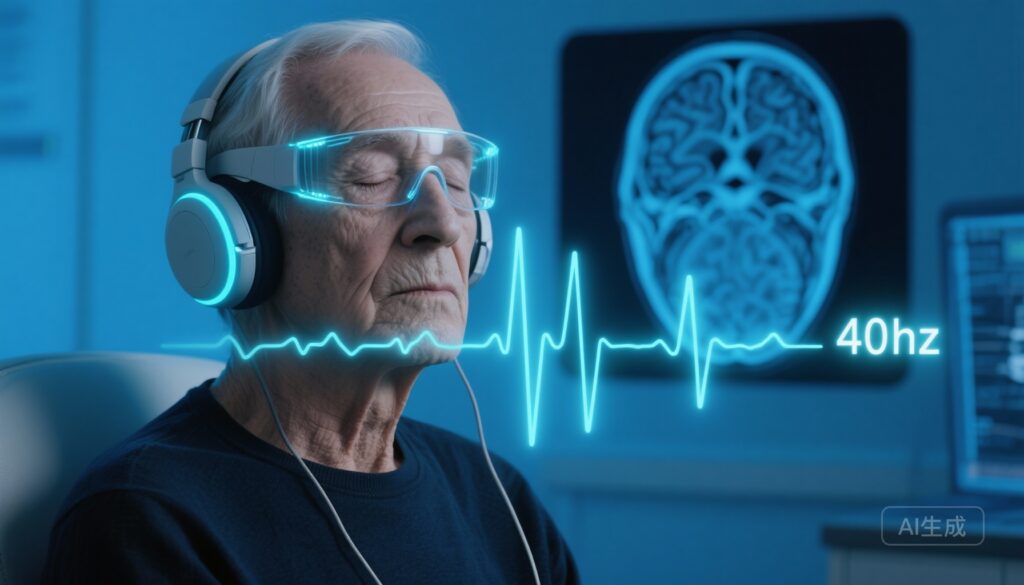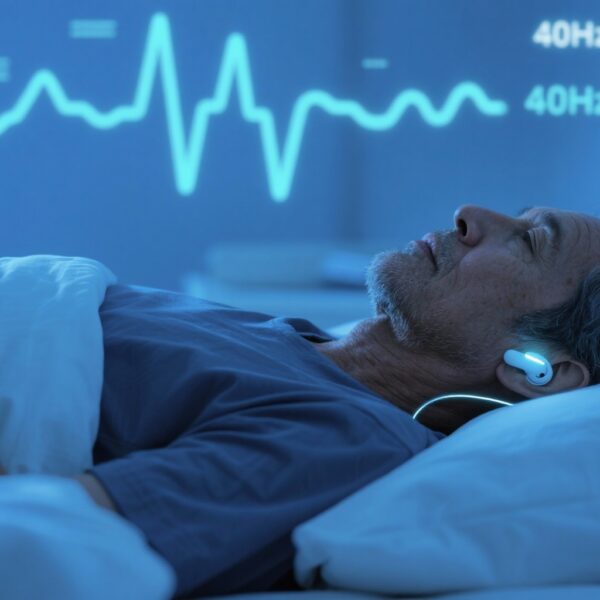Highlights
– Daily 1‑hour 40 Hz audiovisual stimulation over 2 years was well tolerated in five patients with mild Alzheimer’s disease (AD) with no reported adverse events.
– Three late‑onset AD (LOAD) participants showed durable 40 Hz EEG entrainment and smaller declines on MMSE, CDR, and FAS compared with matched registry controls.
– Plasma pTau217, measured with an ultrasensitive S‑PLEX assay, declined in two LOAD participants (−47% and −19%), the first reported long‑term biomarker changes linked to chronic 40 Hz therapy.
– Findings are hypothesis‑generating and support randomized, adequately powered trials with biomarker end points and prespecified subgroup analyses by AD subtype.
Background
Alzheimer’s disease (AD) is a progressive neurodegenerative disorder with substantial individual and public health burden and limited disease‑modifying therapies. Noninvasive neuromodulation strategies are being explored as potential adjunctive approaches to modify disease processes or slow clinical decline. Preclinical work demonstrated that sensory entrainment at gamma frequencies (around 40 Hz) can reduce amyloid burden and alter neuroimmune responses in mouse models of AD, and multisensory 40 Hz stimulation improved cognition in some animal studies (Iaccarino et al., Nature 2016; Martorell et al., Nature 2019). Early human feasibility work has focused on safety, tolerability, and evidence of cortical entrainment; however, long‑term data on clinical outcomes and fluid biomarkers have been limited. The study by Chan et al. (2025) reports a 2‑year open‑label extension of daily 40 Hz audiovisual stimulation in five patients with mild AD, providing rare long‑term human data linking sustained entrainment to clinical and plasma biomarker outcomes.
Study design
This was an open‑label extension study (ClinicalTrials.gov NCT04055376) assessing long‑term safety, adherence, neural entrainment, cognition, imaging, activity patterns, and plasma biomarkers in five individuals with mild AD who used a home-based audiovisual device delivering 40 Hz stimulation for 1 hour per day over 2 years. Evaluations included:
- Electroencephalography (EEG) to assess cortical entrainment at 40 Hz.
- Magnetic resonance imaging (MRI) to measure brain volumes and structural change.
- Actigraphy to monitor daily activity and sleep‑wake patterns.
- Neuropsychological testing (Mini‑Mental State Examination [MMSE], Clinical Dementia Rating [CDR], Functional Assessment Scale [FAS]) to follow cognition and function.
- Plasma pTau217 measured by S‑PLEX (ultrasensitive electrochemiluminescence) to track phospho‑tau biomarker changes.
Comparative context for cognitive trajectories was provided through matched control data drawn from large registries and cohorts: the National Alzheimer’s Coordinating Center (NACC), the Alzheimer’s Disease Neuroimaging Initiative (ADNI), and the Longitudinal Early‑Onset Alzheimer’s Disease Study (LEADS).
Key findings
This section summarizes the principal results reported by Chan et al. (2025). Because the study was an uncontrolled, small open‑label series, emphasis is placed on effect directions, feasibility, safety, and biologic plausibility rather than definitive efficacy.
Safety and adherence
No adverse events attributable to the 40 Hz audiovisual stimulation were reported across the two‑year period. Participants reportedly tolerated daily 1‑hour sessions at home, supporting the feasibility of long‑term home use of noninvasive sensory stimulation devices in mild AD.
EEG entrainment
All three late‑onset AD (LOAD) female participants maintained robust EEG power increases at 40 Hz during stimulation sessions throughout the study, indicating durable cortical entrainment to the gamma‑frequency audiovisual input. The two early‑onset AD (EOAD) participants reportedly had less consistent entrainment, suggesting heterogeneity in neurophysiologic responsiveness that may be related to disease subtype, cortical integrity, or other individual factors.
Cognitive and functional outcomes
Over two years, the three LOAD participants who showed sustained EEG entrainment exhibited smaller declines in key clinical measures (MMSE, global and domain scores on CDR, and FAS) compared with matched control trajectories from NACC, ADNI, and LEADS. Exact effect sizes and confidence intervals are not provided here because the original report focused on descriptive comparisons in a very small sample. The pattern suggests that sustained entrainment may be associated with slower clinical decline in some individuals, but confirmation requires randomized comparison and larger samples.
Plasma pTau217
Plasma samples were available for only two of the five participants (both LOAD). Both showed reductions in pTau217 after two years of daily stimulation: one participant decreased by 47% and the other by 19% relative to baseline, measured using the S‑PLEX assay. These are notable as the first reported long‑term plasma biomarker reductions associated with chronic 40 Hz sensory stimulation in humans. However, the very small sample and absence of controls for assay variability, biological confounders, and natural biomarker fluctuation preclude causal inference.
Imaging and actigraphy
MRI and actigraphy were obtained as part of the protocol. The report does not describe large or consistent group‑level MRI volumetric changes attributable to the intervention; given the sample size and expected slow structural change over two years in mild AD, the study was not powered for imaging endpoints. Actigraphy provided continuous activity data but the report focuses mainly on feasibility of remote monitoring rather than definitive sleep or circadian conclusions.
Expert commentary and interpretation
This open‑label pilot provides several useful signals for translational research while underscoring important limitations.
Biological plausibility
Preclinical studies demonstrated that 40 Hz sensory stimulation can entrain neural circuits, alter microglial phenotypes, and reduce amyloid pathology in mouse models (Iaccarino et al., 2016; Martorell et al., 2019). Human EEG entrainment in this study shows that the stimulus can engage cortical networks over extended periods. The observed reductions in plasma pTau217 in two participants are biologically plausible if chronic network modulation affects tau processing, clearance, or downstream neuroinflammation, but causation is unproven.
Strengths
- Very long follow‑up (2 years) for a neuromodulation feasibility study.
- Multimodal assessments including EEG, plasma biomarkers, MRI, and functional measures.
- Use of registry data (NACC, ADNI, LEADS) to contextualize clinical trajectories.
Limitations and generalizability
- Small sample size (n=5) and open‑label design with no randomized control group prevent causal inference.
- Selective availability of plasma biomarker data (only two participants) limits interpretation of pTau217 findings.
- Potential selection bias: participants who continued into a 2‑year extension may represent a motivated, higher‑functioning subset with better adherence and potentially slower progression.
- Heterogeneity between late‑onset and early‑onset AD participants suggests that responsiveness may differ by subtype, tau/amyloid burden, cortical integrity, or comorbidities; stratified sampling will be crucial in future trials.
- Registry comparisons offer helpful context but cannot substitute for randomized, blinded controls; regression to the mean and other confounders can obscure interpretation.
Implications for research
The data support continued investigation of 40 Hz sensory stimulation in AD. Next steps should include randomized, sham‑controlled trials with prespecified biomarker end points (plasma and CSF tau/amyloid species, neuroimaging markers), formal power calculations, stratification by disease subtype and baseline biomarker status, and exploration of predictors of EEG entrainment responsiveness. Device optimization (intensity, multisensory combinations, session duration), adherence strategies, and mechanistic substudies (microglial imaging, blood inflammatory markers) will help translate preclinical mechanistic insights to clinical endpoints.
Conclusion
Chan et al. (2025) report that long‑term daily 40 Hz audiovisual stimulation was safe and feasible in five individuals with mild AD and that sustained EEG entrainment in late‑onset cases coincided with smaller clinical declines and reductions in plasma pTau217 in two participants. These preliminary signals are encouraging but remain hypothesis‑generating. Well‑designed randomized controlled trials with robust biomarker panels and stratified analyses are required to determine whether sustained gamma entrainment can meaningfully alter disease trajectory in AD.
Practical takeaways for clinicians
– 40 Hz audiovisual sensory stimulation is noninvasive and was well tolerated over two years in a very small cohort of patients with mild AD.
– Durable EEG entrainment may identify individuals more likely to show clinical or biomarker responses; EEG could serve as a pharmacodynamic marker in trials.
– Plasma pTau217 is an emerging blood biomarker that may be sensitive to interventions targeting disease biology and should be incorporated in future controlled studies of neuromodulation approaches.
– Until results from randomized controlled trials are available, clinicians should consider such interventions experimental and discuss uncertainties with patients and caregivers.
Funding and clinical trial registration
ClinicalTrials.gov Identifier: NCT04055376. Funding and detailed disclosures are reported in the primary publication (Chan et al., Alzheimers Dement. 2025 Oct;21(10):e70792).
Selected references
– Chan D, de Weck G, Jackson BL, et al. Gamma sensory stimulation in mild Alzheimer’s dementia: An open‑label extension study. Alzheimers Dement. 2025 Oct;21(10):e70792. doi:10.1002/alz.70792 IF: 11.1 Q1 . PMID: 41137616 IF: 11.1 Q1 ; PMCID: PMC12552893 IF: 11.1 Q1 .- Iaccarino HF, Singer AC, Martorell AJ, et al. Gamma frequency entrainment attenuates amyloid load and modifies microglia. Nature. 2016;540(7632):230–235.
– Martorell AJ, Paulson AL, Suk HJ, et al. Multi‑sensory gamma stimulation ameliorates Alzheimer’s‑associated pathology and improves cognition. Nature. 2019;565(7741):1–6.
– Alzheimer’s Association. 2023 Alzheimer’s Disease Facts and Figures. Alzheimers Dement. 2023;19(4):1598–1696.



